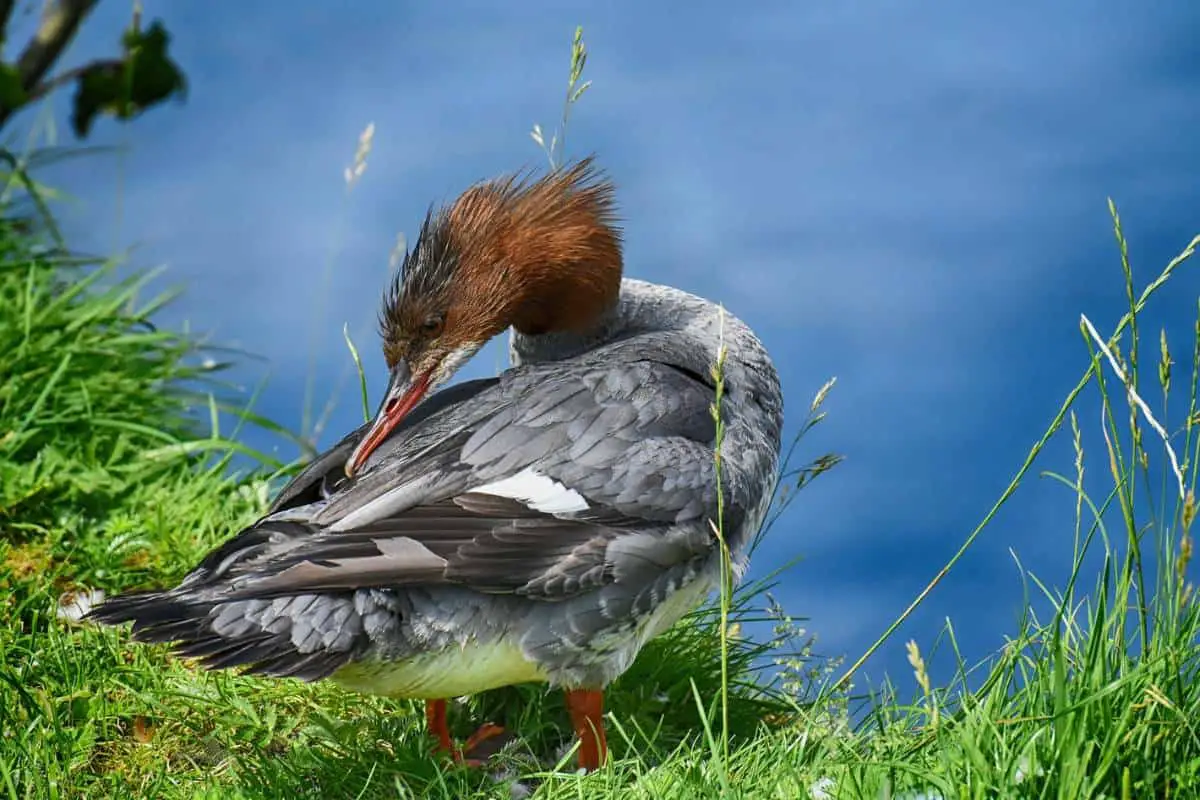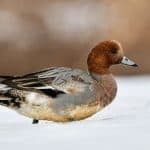Common Name: Common Merganser
Scientific Name: Mergus merganser| Size | Diet | Range in Hawaii | Status in Hawaii |
|---|---|---|---|
| 22 in. - 28 in. | fish | Unknown | Least Concern |
Welcome to a captivating exploration of the Common Merganser (Mergus merganser), a majestic diving duck found across North America, Europe, and Asia. While Hawaii’s unique ecosystem poses a challenge for their permanent residence, occasional sightings have sparked excitement among birdwatchers. Join us as we unravel the mysteries of the Common Merganser and its unexpected appearances in the tropical paradise of Hawaii.
Let’s dive into the wonders of these extraordinary birds!
Common Merganser
Appearance
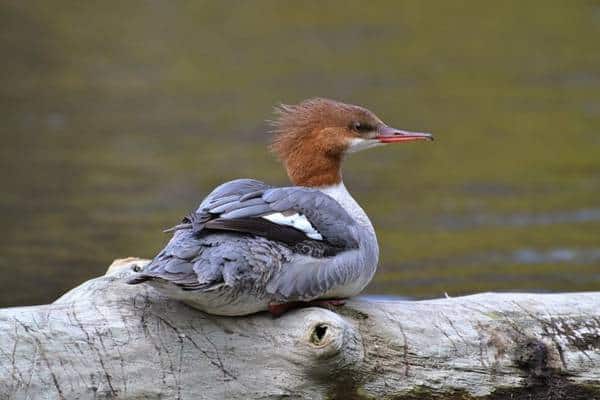
The Common Merganser is a visually captivating diving duck that commands attention with its stunning appearance. The male Common Merganser boasts a regal presence, with a glossy black head, a bright white body, and a striking green sheen. It stands at an impressive size of approximately 22-28 inches (55-70 centimeters) in length, making it a substantial and eye-catching waterfowl.
In contrast, the female Common Merganser exhibits a more subtle beauty, featuring a soft cinnamon-colored head and a pale grey body that perfectly complements her surroundings.
Diet
The diet of the Common Merganser is as impressive as its striking appearance. These diving ducks are skilled hunters, specializing in capturing a diverse array of aquatic prey. Their diet primarily consists of fish, with species such as trout, salmon, and perch being their preferred targets.
Nesting
The nesting habits of the Common Merganser are as fascinating as their graceful presence on water. Female Common Mergansers demonstrate remarkable nesting instincts, often choosing cavities in trees or utilizing natural cavities created by other animals as their preferred nesting spots.
The females construct their nests using a combination of twigs, leaves, grass, and down feathers, creating a comfortable and secure environment for their eggs. These nests can be found both on the ground and in elevated locations such as tree hollows or rock crevices, providing protection from potential predators and water-level fluctuations.
Once the nest is prepared, the female lays a clutch of eggs, which typically ranges from 6 to 17 eggs, depending on factors such as the female’s age and environmental conditions. She diligently incubates the eggs for about a month, carefully turning them to ensure even heat distribution and proper development.
Once the eggs hatch, a remarkable scene unfolds as the fluffy, striped ducklings emerge and eagerly follow their mother to the water. Common Merganser ducklings are known for their remarkable agility and ability to swim shortly after hatching, captivating onlookers with their endearing presence.
Behavior
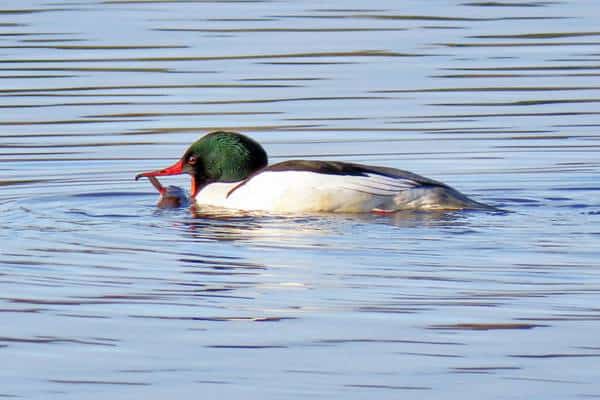
The behavior of the Common Merganser is a captivating display of adaptability, social dynamics, and remarkable hunting techniques. These diving ducks are highly gregarious and often gather in flocks during migration and winter months, creating a lively and communal atmosphere.
One intriguing aspect of their behavior is their affinity for water. Common Mergansers are adept swimmers, utilizing their streamlined bodies and webbed feet to gracefully navigate lakes, rivers, and coastal areas. With a remarkable ability to dive underwater for extended periods, they display their incredible hunting skills, chasing after fish and other aquatic prey with remarkable agility and speed.
The Common Merganser is also known for its courtship rituals, which are nothing short of fascinating. The males engage in elaborate displays to attract females, including head-throwing movements, wing flapping, and various vocalizations. These captivating performances not only showcase the male’s prowess but also serve as a means to establish dominance and court potential mates.
In addition to their social and reproductive behaviors, Common Mergansers also display interesting communal hunting strategies. They often gather in groups to corral fish into shallow areas, using their collective presence to create a barrier and force the prey into more confined spaces. This cooperative hunting behavior is both efficient and effective, allowing them to secure a bountiful meal for the flock.
Furthermore, during the nesting season, Common Mergansers exhibit fierce parental instincts. The females diligently protect their nests and fiercely defend their young from potential threats, showcasing their unwavering dedication to ensuring the survival of their offspring.
Habitat
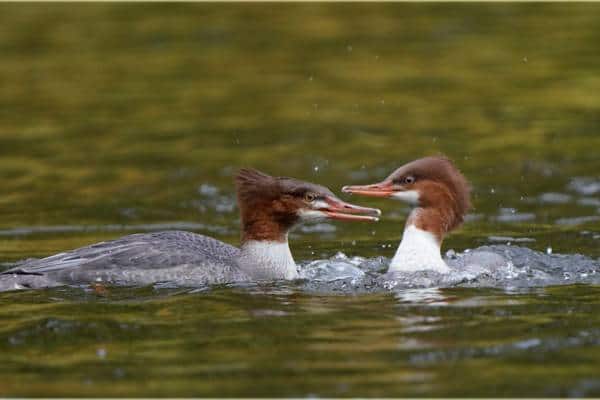
The habitat of the Common Merganser encompasses a diverse range of freshwater environments, making these diving ducks a true marvel of adaptation. They are commonly found near lakes, rivers, and streams, where they can indulge in their preferred aquatic lifestyle.
Range
The range of the Common Merganser in Hawaii has piqued interest due to occasional sightings. These diving ducks are typically found in freshwater habitats across North America, Europe, and Asia.
While not a resident species, reports and sightings suggest that migratory Common Mergansers may occasionally visit Hawaii during their migrations. There have been notable sightings, including on Midway Atoll, adding to the excitement of birdwatchers and researchers studying avian diversity in the region.
Conservation Status
The Common Merganser is assessed as a species of “Least Concern” on the IUCN Red List. This classification indicates that the overall population of the species is stable and not currently facing a significant risk of extinction.
Interesting Facts
1. Also known as “Goosander”
“Common Merganser” is the preferred name used in North America to refer to this species while the term “Goosander” is commonly used in Europe and Asia. They both belong to the scientific name Mergus merganser. Despite the difference in names, they are essentially the same bird with slight regional variations in terminology.
2. Fishing in Formation
Common Mergansers often employ a unique hunting strategy called “fishing in formation.” They gather in groups and create a cooperative barrier in the water, herding fish towards shallower areas where they can be easily caught and consumed.
3. Nomadic Nesters
Unlike many other ducks, Common Mergansers do not build nests in the same location year after year. They are known as “nomadic nesters” and seek out new nesting sites each breeding season, utilizing tree cavities, rock crevices, or other suitable sheltered locations.
4. Fast-flying Flock
When Common Mergansers take to the air, they exhibit impressive speed and agility. Flying in tight formations, these ducks can reach speeds of up to 50 miles per hour (80 kilometers per hour), making for an awe-inspiring sight.
5. Mismatched Broods
It is not uncommon to see Common Merganser females caring for broods that consist of mixed ages and sizes. Sometimes, they will adopt or assimilate orphaned or lost ducklings into their own brood, showcasing their nurturing and adaptable nature.
Frequently Asked Questions
1. What is the difference between a Common Merganser and a Hooded Merganser?
While both Common Mergansers and Hooded Mergansers belong to the Merganser family, they are distinct species. Common Mergansers have a mostly white body with a greenish-black head, while Hooded Mergansers have a black body with a large white crest and a distinct black and white pattern on their head.
2. Do Common Mergansers make any sounds?
Yes, Common Mergansers have various vocalizations. Males produce low, raspy croaks or growls, especially during courtship displays. They also have softer calls used for communication with their young and other flock members.
3. How long do Common Mergansers live?
Common Mergansers typically have a lifespan of 5 to 10 years in the wild, although some individuals can live longer. Survival rates can vary based on factors such as predation, habitat conditions, and food availability.
4. Are Common Mergansers territorial?
Common Mergansers can exhibit territorial behavior, particularly during the breeding season. Males may establish and defend territories to attract and court females. They may engage in aggressive displays and interactions with other males in defense of their territory.
5. Are Common Mergansers good divers?
Yes, Common Mergansers are excellent divers. They can dive to considerable depths, using their webbed feet to propel themselves underwater in search of prey. They have a streamlined body and a keen ability to navigate underwater environments.
